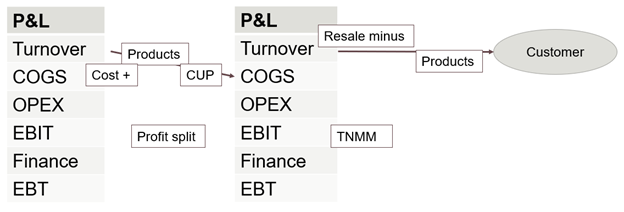Price setting vs price testing
which TP method to apply?

The OECD distinguishes traditional transaction methods and transactional profit methods. The traditional transaction methods compare the intercompany price with the external price of a product or service (gross margin for Cost Plus and Resale Minus or direct product/service price for CUP). The transactional profit method compares the total profit for a type of activity with the total profit of a third party (TNMM) for the same activity or intends to split the profit fairly between parties (profit split).
Theoretically traditional transaction methods are preferred, however in practice transactional profit methods are most commonly applied. The TNMM is most often used due to data availability and to avoid information disadvantage for tax authorities.
In this blog, we will provide a brief explain on which financials the TP methods use in the calculation of the intercompany pricing and how to make use of the characteristics of multiple TP methods.
In the simplified chart above the methods are depicted and the figure that is mainly used to calculate the related intercompany pricing.
Comparable Uncontrolled Price method
The CUP method makes a comparison between the price charged for a specific product/service for a specific quantity at a specific moment with comparable terms and conditions and quantities. For example x amount liter of oil of a certain grade. Typically, there are too much differences between the market prices which makes it difficult to apply the CUP method. In principle, when selling goods or services you would initially like to approximate the market price, i.e. the CUP.
Resale Minus method
The resale price method starts with the price at which a product is resold from an associated enterprise to a third party. Subsequently the resale price gets reduced by an appropriate gross margin on the price. This margin should cover the operating and selling costs while still making a reasonable profit. The amount that remains after the reduction of the gross margin is the at arm’s length price which needs to be applied for the product or service sold to the reseller. For example, a product is externally sold for 100, you expect to require (on average) around 4 to cover the cost of the distributor, a reasonable profit is e.g. considered 2 so you sell the product intercompany for 100-/-4-/-2 = 94. This method makes it relatively easier to approximate the appropriate pricing and include this in your IT-systems and make it operational.
Cost Plus method
The cost plus method looks at the gross costs of an intercompany transaction. An appropriate markup in line with the market conditions and performed functions is added to the gross cost price. The total price should give, for example a manufacturer, an adequate gross margin to cover further operational expenses and leave a fair margin. This method is often confused with the Transactional Net Margin Method with a Net Cost Plus Margin as Profit Level Indicator. A bit similar to the Resale Price method for distributors this method can be helpful in price setting for manufacturers.
Profit Split method
The transactional profit split method looks at the profit and splits it between the associated entities on an at arm’s length basis. The aim of this method is to ensure that the profit is being split in a way that resembles the input given by the associated entities. This method is not applicable if one of the entities merely does routine work and could apply if both parties have unique input and co-develop.
Transactional Net Margin method (TNMM)
The TNMM looks at the net profit (EBIT) relative to an appropriate base (e.g. turnover for sales entities or costs for manufacturing entities, also referred to as Profit Level Indicator) which is being realized from a certain routine activity performed for the other entity. If one entity performs multiples routine services, a segregated P&L should be prepared to calculate the arm’s length remuneration per routine function.
Price setting versus price testing
Traditional transaction methods (Resale minus, Cost Plus and CUP) are not often applied as (ultimate) Transfer Pricing method due to various disadvantages and reliability issues. The theory behind these methods can however often be used for price setting purposes to get already to a profit level that is approximately right. An adjustment can then be applied to get to the profit agreed between parties based upon e.g. the TNMM. Dependent on the countries involved and various roles of entities, you can determine which strategy to apply in this respect. It is for example considered typically more difficult to get profit/cash out of China, which is something to consider. Legislative and cultural differences and the structure of your company can be taken into account in determining the optimal price setting and price testing strategy for your company.
If you would like to see if your Transfer Pricing can be simpler while making your policy more sustainable and compliant, please feel free to reach out for a non-committal initial check.


